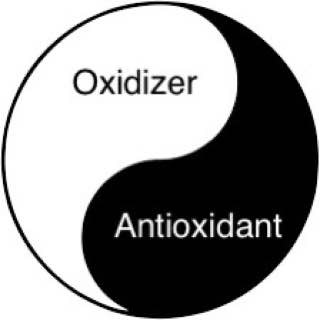How Can Chlorine Dioxide Benefit a Healthy Person?
Is Chlorine Dioxide only for sick people?
Note: This is for educational purposes. This is not medical advice, and I am not telling you what you should do. Every person is or should be in control of their own health in spite of what the current medical establishment would like you to believe.
The benefits of chlorine dioxide (ClO2) are primarily related to its oxidative, cell signaling, and hormetic roles. While we've often been told that oxidizers (free radicals) are bad and antioxidants are good, this view is overly simplistic. Antioxidants are generally safer than oxidizers, but oxidation is an essential process for biological life. These reactive molecules, once viewed merely as damaging byproducts of cellular metabolism, are now recognized as essential components of normal biological processes. [1]
The Balance of Oxidizers and Antioxidants
To understand the relationship between oxidizers and antioxidants, we can use the Chinese concept of yin and yang. This illustration reasonably explains opposing forces working together to ensure biological homeostasis and redox balance.
Chlorine dioxide is a reactive oxygen species (ROS), similar to hydrogen peroxide, hypochlorous acid, and superoxide, which are produced naturally in the body. ROS serve as crucial signaling molecules in various cellular functions including cell growth, proliferation, and stress responses. Antioxidants maintain a balance by neutralizing excess ROS, and when maintained in balance both oxidizers (ROS) and antioxidants work in harmony resulting in health and longevity. [2]
At moderate or controlled concentrations, oxidants serve as crucial signaling molecules and contribute to numerous vital physiological processes. This functionality represents a paradigm shift from earlier views that characterized oxidants solely as harmful metabolic byproducts. [2,3,4]
Unique Properties of Chlorine Dioxide
Among reactive oxygen species, chlorine dioxide has the lowest oxidation strength (even lower than oxygen) but the highest oxidative capacity. This means that ClO2 can be consumed at low concentrations without damaging the body due to its low oxidation strength. During its active phase in the body before being reduced by antioxidants like glutathione, ClO2 can neutralize pathogens and stimulate mitochondria through a process known as mitochondrial hormesis. [2]
Mitochondrial Hormesis: A Beneficial Stress
Mitochondrial hormesis induced by ROS can be compared to the benefits of weightlifting or physical exercise. Just as exercise applies stress to the body, prompting it to adapt and become stronger, mild stressors can trigger beneficial cellular responses. However, excessive stress can be harmful, as seen in high-endurance athletes who overtrain. Similarly, interventions like chlorine dioxide can provide health benefits when used appropriately but may cause harm if misused.
In fact, various interventions such as calorie restriction, physical exercise, heat stress (e.g., sauna use), and hypoxic stress all involve mild stressors that result in the production of moderate amounts of reactive oxygen species (ROS). These ROS, in turn, trigger adaptive responses that yield health benefits. This process exemplifies the concept of hormesis, where low doses of a potentially harmful agent can produce beneficial effects.[2]
Proper Usage for Optimal Health
For maintaining optimal health, Chlorine Dioxide should be used judiciously, similar to how one approaches exercise. Here are two methods for a "chlorine dioxide workout":
Method 1
Twice a week, prepare a liter bottle with 10-15 activated drops of MMS1. Consume the entire bottle over 2-3 hours, taking a drink every 15 minutes. (If using CDS, the same thing can be accomplished by placing 10 mL of CDS 3000 ppm in 1 L of water.)
Method 2
Take 2-3 drops of activated MMS1 every morning and night daily.
It's important to note that following Protocol 1000 (taking ClO2 hourly) every day for an extended period could potentially stress the body and cause more harm than good. For most people, an initial 21-day course of Protocol 1000 for detoxification and cleansing is sufficient.
Conclusion
For healthy individuals, using Chlorine Dioxide 2-3 times a week as described above can provide benefits without causing harm. When consumed properly, it should not make you feel tired, rundown, or sick. However, it's crucial to remember that there may be subtle differences in approach when dealing with chronic diseases like cancer, cardiovascular disease, diabetes, etc.
In the same way, that people make up their own exercise workouts, once a person has a good understanding of how their body responds to chlorine dioxide they can even make up their own maintenance regimen that fits their schedule.
Sources
1. Pizzino G, et al. Oxidative Stress: Harms and Benefits for Human Health. Oxid Med Cell Longev. 2017;2017:8416763.
https://pmc.ncbi.nlm.nih.gov/articles/PMC5551541/
2. Ristow M, Schmeisser K. Mitohormesis: Promoting Health and Lifespan by Increased Levels of Reactive Oxygen Species (ROS). Dose Response. 2014 Jan 31;12(2):288-341.
https://pmc.ncbi.nlm.nih.gov/articles/PMC4036400/
3. Bardaweel SK, et al. Reactive Oxygen Species: the Dual Role in Physiological and Pathological Conditions of the Human Body. Eurasian J Med. 2018 Oct;50(3):193-201.
https://pmc.ncbi.nlm.nih.gov/articles/PMC6263229/
4. Ray PD, Huang BW, Tsuji Y. Reactive oxygen species (ROS) homeostasis and redox regulation in cellular signaling. Cell Signal. 2012 May;24(5):981-90.






Fantastic article and came at a perfect time! I’ve been trying to understand better what I need for maintenance dose as I am in pretty good health… And this has been extremely helpful.
Thank you Curious Outlier!!
"Healthy people" is not a defined term. The phrase is generally used to describe people who are "not diseased."
Perhaps a better phrasing would be "Can chlorine dioxide make people healthier, irrespective of any disease status?" Unfortunately, we have no techniques to measure "healthiness" in any specific way, much less to measure general or overall healthiness. But we can develop these techniques if we wish.